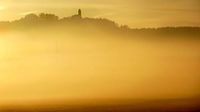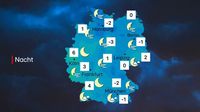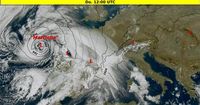As temperatures climb across Europe, a significant weather event marked by the second wave of Saharan dust is set to impact Germany starting Friday, March 21, 2025. This event is predicted to reach its peak over the weekend, significantly altering weather conditions in various regions.
The current weather brings milder temperatures, with highs potentially reaching up to 24 degrees Celsius. Such warmth marks the onset of spring, officially began on March 20, 2025, as a stable high-pressure system, known as Omega-High KONSTANTINA, allows for ample sunshine. However, it is accompanied by Saharan dust, which will obscure skies, particularly in the southwest and parts of the northern regions. This duality of spring warmth and dust clouds creates a unique meteorological phenomenon.
Weather models, including the CAMS (Copernicus Atmosphere Monitoring Service), predict a series of changes as the dust cloud flows into the region. The model forecasts that this diluted dust layer will reach Switzerland around Friday evening, further pushing into Germany. These dust concentrations can impact air quality and visibility, prompting meteorologists to monitor the situation closely.
According to the CAMS, the Aerosol Optical Depth (AOD) measures the level of sunlight attenuated by the dust layer. Higher values indicate more dust in the atmosphere, leading to decreased sunlight at ground level. Past weather patterns, such as the similarly warm and dusty Easter weekend in 2024, serve as reference points for understanding how this current event might unfold.
The Saharan dust is not merely a backdrop for a nice spring day; it has implications for air quality. The incoming dust cloud is expected to result in increased particulate matter in the atmosphere, which can lead to the phenomenon known as 'blood rain'—a term used when precipitation washes the dust out of the air, leaving a reddish hue. This is particularly likely over the southwestern regions of Germany where the concentration of dust will be highest.
As the dust cloud reaches southwestern Germany during the night of March 21, it will shift northeastward by the following day, affecting areas as far as Berlin-Brandenburg. According to the Skiron model from the University of Athens, the substantial influx of sand and dust from North Africa will transition into greater visibility reductions and hazy conditions by Saturday, March 22, 2025.
While the dust settles into the atmosphere, meteorologists are also keeping an eye out for developing weather patterns, as low-pressure systems from the Atlantic are expected to move in. Beginning on Sunday, March 23, the western and southern regions of Germany might experience showers and even localized thunderstorms. The Saharan dust, meanwhile, will contribute to a milky appearance of the sky, altering not just the air quality but also the overall aesthetic of spring skies.
Regions with traditionally milder rates of dust**—like the high-alpine areas—are expected to experience different weather dynamics than flatlands. Meteorologists note that the geographical context plays a significant role, as mountains can create variability in how the dust settles.
The country's climate health comes into sharper focus with the report that wildfire risks are in elevated states across several regions due to dry weather conditions. The eastern and northern parts of Germany could see slightly varying temperatures, but many areas will register a shift from a spring-like warmth to a more volatile weather pattern as the week progresses.
Meteorologists also advise caution in the wake of increased fire danger, as the ostensible springtime warmth is misleading. Wildfires have been a growing concern recently, as noted by the heightened alert levels (level 4) in regions like the Lüneburg Heath. Officials recommend avoiding open flames outdoors to mitigate risks.
The Saharan dust and meteorological shifts come as the world grapples with broader environmental changes. Reports indicate that Germany’s wine production has declined significantly due to recent adverse weather phenomena, with production down nearly 10% in 2024 compared to previous years. This includes significant drops in specific regions due to frosts and storms, prompting agricultural concerns.
Such weather patterns are not just isolated incidents but part of recurring climate patterns that experts continuously analyze. As scientists and weather professionals monitor the ongoing developments, the public is encouraged to remain informed and prepared for rapid changes, especially as Saharan dust clouds make their presence known this spring.
Ultimately, the interplay of Saharan dust and regional weather is a complex narrative, reflective of both daily experiences and larger climate realities. Observers in Germany and beyond will undoubtedly document this ongoing saga—one where warming spring temperatures meet the ochre grittiness of desert dust.








